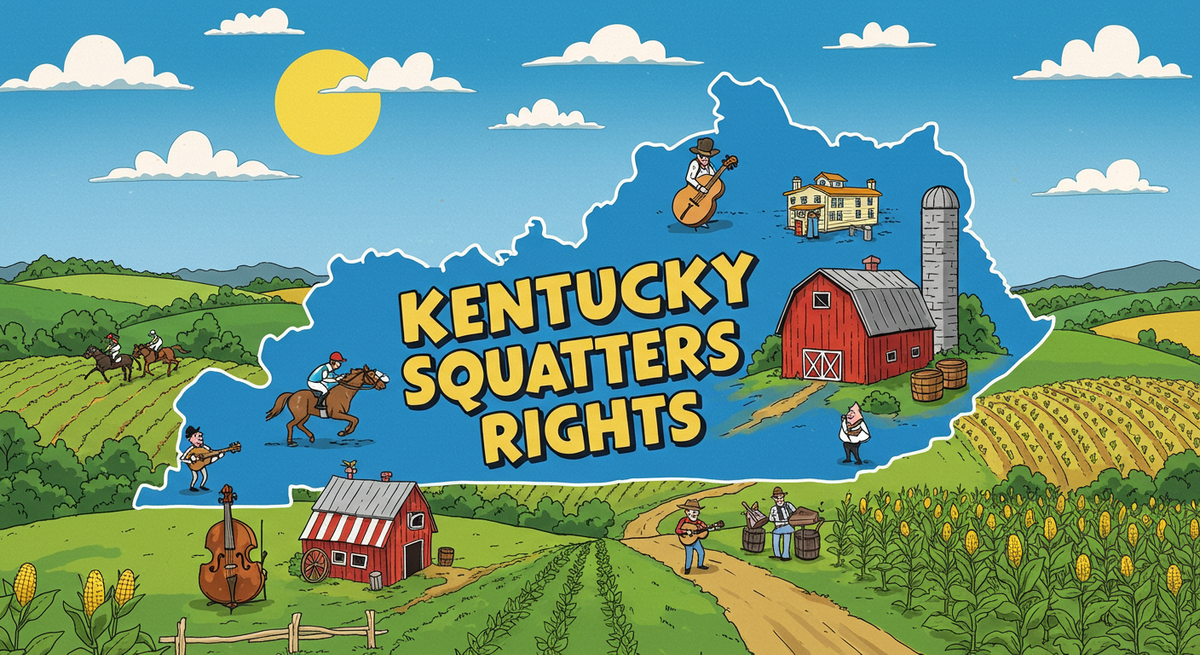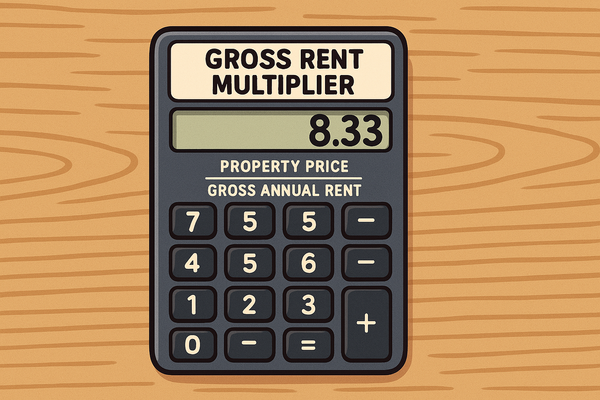Kentucky Squatter's Rights Guide: 2025 Laws, HB 142, and Property Protection 🏠
Kentucky requires squatters to occupy property continuously for 15 years before filing an adverse possession claim

The Louisville Homeowner's Nightmare: When Good Deeds Lead to Homelessness 😱
The shocking case of Daniel Toma offers a sobering window into Kentucky's precarious property rights landscape. When this Louisville homeowner compassionately offered his garage to stranded friends, he couldn't have imagined the Kafkaesque legal nightmare that would follow: being legally barred from his own home while unwelcome guests claimed squatter's rights. Through a clever legal maneuver—filing a protective order describing Toma as merely a "roommate" rather than the property owner—these opportunistic occupants engineered a situation where Toma was forced to maintain a 500-foot distance from his own property.
This isn't just an isolated horror story; it's a stark illustration of the vulnerabilities baked into Kentucky's current property laws—vulnerabilities that leave well-meaning property owners exposed to exploitation while the state legislature scrambles to catch up with more progressive approaches seen in neighboring jurisdictions.
Introduction: Kentucky's Adverse Possession Landscape Demands Attention 📋
Kentucky's approach to squatter's rights represents a fascinating intersection of antiquated property doctrines and modern reform efforts. While unauthorized occupation remains technically illegal, the state's 15-year adverse possession window creates a lengthy vulnerability period that stands in stark contrast to more owner-friendly frameworks emerging across the country.
Key Takeaways: The Essential Intelligence Kentucky Property Owners Need Now
- Kentucky maintains a 15-year continuous occupation requirement before adverse possession claims can be filed—significantly longer than Florida's 7-year window but more lenient than Ohio's 21-year threshold
- House Bill 142, introduced January 2025, represents a potential paradigm shift that would classify squatting as a Class D felony
- Successful adverse possession requires meeting the five-point framework: actual, hostile, exclusive, open/notorious, and continuous possession
- Kentucky courts additionally require "definiteness"—either clearly defined boundaries or "color of title"
- Regular property inspections and comprehensive security measures remain your frontline defense against potential occupation
- Despite reform efforts, Kentucky currently lags behind states like Florida and Texas in property owner protections
- The Daniel Toma case reveals how even initially consensual arrangements can morph into complex legal nightmares through Kentucky's judicial interpretation
The interplay between property rights and adverse possession doctrine in Kentucky creates a challenging landscape for homeowners that demands both vigilance and legal sophistication.
Understanding Kentucky Squatter Rights in 2025: A System at a Crossroads 🔍
When we examine Kentucky's current squatter landscape, we're looking at a state caught between historical property doctrines and emerging recognition of the need for reform. Unlike Florida's aggressive anti-squatter stance enacted through HB 621, Kentucky continues to approach unauthorized occupation primarily through civil rather than criminal frameworks.
The distinction between squatting and trespassing takes on particular importance in Kentucky's legal context. While trespassing represents temporary unauthorized entry, squatting involves establishing residence on a property without authorization for an extended period. This distinction determines whether police can immediately remove the individual (trespassing) or whether formal eviction proceedings are required (squatting).
What makes Kentucky's approach particularly interesting is the potential paradigm shift represented by House Bill 142. Representative Marianne Proctor's January 2025 legislation signals growing recognition that Kentucky's civil approach may be insufficient to address contemporary squatting challenges. The bill's proposal to classify squatting as a Class D felony would align Kentucky more closely with states like Florida and Texas, which have moved decisively toward criminalization frameworks.
This legislative shift comes amid increasing recognition that Kentucky's lengthy 15-year adverse possession window creates extended vulnerability periods for property owners—vulnerability tellingly illustrated by cases like Daniel Toma's nightmare scenario.
Kentucky's Adverse Possession Requirements: The 15-Year Mountain to Climb ⏳
Kentucky sets a high bar for adverse possession through its significant time requirement and multi-faceted qualification framework. The state's 15-year statutory period represents a substantial hurdle for potential adverse possession claims and provides property owners with an extended window to assert their rights.
The Five-Point Framework: Kentucky's Adverse Possession Litmus Test
Actual Possession: Beyond Mere Claims
The requirement for actual possession demands physical occupation—not merely asserting ownership rights. Courts look for evidence of genuine possession activities: maintaining the property, making improvements, and demonstrating actions consistent with ownership. This requirement ensures that paper claims alone cannot establish adverse possession without corresponding physical presence.
Hostile Possession: The Counterintuitive Requirement
Perhaps the most misunderstood element, "hostile" possession doesn't require antagonism but rather occupation without permission and against the owner's rights. This element distinguishes adverse possession from permissive use arrangements—a distinction with crucial implications for relationships like landlord-tenant or casual permission scenarios.
Exclusive Possession: The Sole Occupant Standard
For adverse possession to succeed, the squatter must demonstrate exclusive control—not sharing the property with the legal owner or others. This exclusivity requirement reinforces the adversarial nature of the claim and ensures that shared occupancy scenarios cannot lead to ownership transfer.
Open and Notorious Possession: No Hiding Allowed
Kentucky courts demand that occupation be visible and obvious—preventing hidden or secretive occupation from qualifying. The squatter must live openly as if they were the rightful owner, making their presence known in ways that would reasonably alert the true owner to their claim.
Continuous Possession: The 15-Year Marathon
Unlike many states with shorter timeframes, Kentucky requires the full 15-year continuous occupation period—a marathon of uninterrupted presence that resets entirely with any significant abandonment. This extended timeframe creates substantial breathing room for property owners to identify and address unauthorized occupation before adverse possession can succeed.
Kentucky's Distinctive "Definiteness" Requirement
Beyond the standard five elements, Kentucky courts impose an additional "definiteness" threshold. For a claim to qualify as sufficiently definite, the squatter must either "indicate the extent of his claim by well-defined boundaries" (such as erecting a fence) or possess "color of title" (documentation that appears to establish ownership despite legal defects).
This definiteness requirement adds yet another hurdle for potential adverse possession claims in Kentucky's already challenging landscape.
House Bill 142: Kentucky's Potential Property Rights Revolution 📜
January 2025 marked a potential watershed moment in Kentucky property rights with Representative Marianne Proctor's introduction of House Bill 142. This ambitious legislation aims to dramatically reshape how unauthorized property occupation is addressed throughout the Commonwealth.
The Revolutionary Provisions of HB 142
Criminal Classification Upgrade
The bill's most transformative element would elevate squatting from its current misdemeanor status to a Class D felony—signaling a fundamental shift in how Kentucky conceptualizes unauthorized occupation. This classification change acknowledges the profound harm that squatting inflicts on property owners and aligns Kentucky with states taking more aggressive anti-squatter stances.
Expedited Removal Framework
Perhaps most beneficial for property owners, the bill establishes a streamlined pathway for law enforcement to remove squatters under specific conditions. This provision represents a dramatic departure from Kentucky's traditionally cumbersome civil eviction processes, potentially reducing removal timelines from months to days.
Law Enforcement Liability Protection
Recognizing the hesitancy that liability concerns can create among law enforcement agencies, HB 142 includes specific protections for officers acting in good faith when removing squatters. This protection aims to encourage more proactive police involvement in addressing unauthorized occupation.
Anti-Fraud Provisions
The legislation also targets an often-overlooked aspect of squatting—fraudulent property sales. By establishing felony penalties for attempting to sell properties illegally occupied, the bill addresses sophisticated squatting operations that leverage apparent occupation to perpetrate property fraud.
The Political Momentum Behind HB 142
The bill's sponsorship by Northern Kentucky Republican lawmakers—including Representatives T.J. Roberts, Steve Doan, and Mark Hart—signals strong regional momentum behind strengthening property owner protections. This coalition reflects growing recognition across Kentucky's political landscape that the state's current approach to squatting inadequately protects legitimate property interests.
If enacted, HB 142 would represent Kentucky's most significant property rights reform in decades, potentially transforming the state from a middle-of-the-road jurisdiction on squatter protections to one of the nation's more owner-friendly environments.
Kentucky vs. The Nation: How the Commonwealth Compares 🧮
Understanding Kentucky's position relative to other states provides crucial context for evaluating the adequacy of current protections and the potential impact of proposed reforms.
Adverse Possession Timeframes: The National Spectrum
Kentucky's 15-year requirement places it roughly in the middle of the national spectrum—more generous to property owners than California's 5-year or Florida's 7-year windows, but less protective than Ohio's 21-year threshold.
| State | Required Occupation Period | Tax Payment Required |
|---|---|---|
| Kentucky | 15 years (7 with color of title) | Varies by jurisdiction |
| Florida | 7 years | Yes |
| Ohio | 21 years | No |
| Texas | 10 years (3 with deed) | Yes |
| Arizona | 3 years (with deed and taxes) | Yes |
| California | 5 years | Yes |
| Georgia | 20 years (7 with deed) | Yes |
The Enforcement Gulf: Civil vs. Criminal Approaches
Where Kentucky most significantly lags behind progressive states is in its enforcement mechanisms. While Florida's HB 621 established clear criminal penalties and expedited removal processes, Kentucky currently restricts property owners to often lengthy civil proceedings—a stark contrast that House Bill 142 aims to address.
This enforcement gulf creates practical implications for Kentucky property owners, who may face months of unauthorized occupation while pursuing civil remedies, compared to Florida owners who can potentially secure law enforcement removal within days.
The Legislative Momentum Trend
Kentucky's House Bill 142 aligns with a discernible national trend toward strengthening property owner protections against squatters. From Florida's HB 621 to Texas's similar reforms, state legislatures increasingly recognize the inadequacy of traditional adverse possession frameworks in addressing contemporary squatting challenges.
These legislative shifts represent a modern recalibration of the balance between protecting legitimate adverse possession claims and preventing exploitation of property rights—a recalibration that Kentucky appears poised to join.
Strategic Prevention: Your Property's First Line of Defense 🔒
For Kentucky property owners, prevention remains far more effective than remediation when dealing with potential squatter situations. A comprehensive prevention strategy combines physical security, regular monitoring, and legal documentation to create multiple barriers against unauthorized occupation.
The Essential Prevention Toolkit for Kentucky Properties
Regular Property Inspection: The Foundation of Prevention
Consistent property monitoring represents your most effective deterrent against potential occupation. Whether conducted personally or through professional management services, regular inspections create documented evidence of active ownership interest—directly countering potential adverse possession claims based on owner abandonment.
For remote or vacation properties, consider quarterly documented inspections with photographs and detailed condition reports. These records serve both preventive and evidentiary purposes should legal challenges arise.
Creating the Perception of Occupation
Vacant properties present particularly attractive targets for potential squatters. Creating the impression of active occupation through strategic measures can significantly reduce this vulnerability:
- Motion-activated lighting systems that activate during evening hours
- Timed interior lighting programmed to simulate occupancy patterns
- Regular lawn maintenance and exterior upkeep
- Periodic vehicle presence in driveways or parking areas
These measures create psychological deterrents against occupation attempts while demonstrating the property owner's continued interest and involvement.
Comprehensive Security Implementation
Physical security measures provide tangible barriers against unauthorized entry:
- Commercial-grade deadbolts on all exterior doors
- Window reinforcement systems or security bars where appropriate
- Visible security cameras with remote monitoring capabilities
- Smart home security systems with real-time alerts
- Security company signage prominently displayed
The security investment typically proves minimal compared to the potential costs of addressing established squatter situations through legal channels.
Neighborhood Surveillance Networks
Establishing relationships with neighbors around vacant properties creates an informal surveillance network that multiplies your monitoring capacity. Providing neighbors with:
- Your direct contact information
- Property management contact details
- Clear instructions for reporting suspicious activity
- Occasional token appreciation for their vigilance
This neighborhood involvement strategy leverages community connections to extend your property monitoring capabilities while creating potential witnesses to any unauthorized entry attempts.
Explicit Documentation of Permissive Use
The Daniel Toma case highlights the dangers of informal permission arrangements. When allowing others temporary use of your property:
- Create explicit written agreements specifying permission terms
- Clearly document the temporary nature of any arrangement
- Include specific end dates for permissive use
- Maintain signed acknowledgment of your continuing ownership rights
- Consider having these agreements notarized for additional verification
These formal documentation practices prevent potential claims that occupation was "hostile" (without permission) for adverse possession purposes.
When Prevention Fails: The Kentucky Squatter Removal Roadmap 📋
Despite preventive efforts, Kentucky property owners may still encounter squatter situations requiring decisive response. Understanding the current legal removal framework—and potential changes under HB 142—is essential for effective remediation.
Current Removal Process: The Civil Pathway
1. Status Determination: Trespasser vs. Squatter
The first critical assessment determines whether the unauthorized occupants qualify as trespassers (no established residence) or squatters (established residence). This distinction affects removal options:
- Trespassers can typically be removed immediately by police officers
- Squatters generally require formal eviction proceedings
2. Formal Eviction Notice
Kentucky law requires serving appropriate eviction notices based on the specific circumstances:
- 7-day notice to pay or quit (for nonpayment situations)
- 14-day notice to cure or quit (for lease violations)
- 30-day notice for other situations
The notice must be properly served according to Kentucky statutory requirements to establish valid legal foundation for subsequent proceedings.
3. Forcible Detainer Complaint Filing
If the notice period expires without resolution, property owners must file a Forcible Detainer Complaint with the Kentucky District Court in the county where the property is located. This formal legal filing initiates court proceedings and requires:
- Filing fees (typically $75-150 depending on jurisdiction)
- Proof of property ownership
- Documentation of proper notice service
- Specific details regarding the unauthorized occupation
4. Court Proceedings and Judgment
The court schedules an eviction hearing where property owners must present evidence establishing their lawful ownership and the unauthorized nature of the occupation. If the judge rules favorably, the court issues a Warrant for Possession authorizing the sheriff to remove the squatter.
5. Sheriff's Execution of Warrant
Kentucky law provides squatters with seven days to appeal the judgment or vacate the property. If they fail to do either, the sheriff executes the warrant and physically removes the squatter—a process that typically requires additional fees and scheduling coordination with the sheriff's office.
This traditional process typically requires 4-8 weeks from initial notice to actual removal—a timeline that House Bill 142 aims to dramatically reduce through its expedited law enforcement provisions.
Potential Process Under HB 142: The Criminal Pathway
If House Bill 142 passes, property owners would gain access to a potentially faster removal pathway:
1. Law Enforcement Request
Property owners could request police assistance in removing squatters if:
- The squatters entered the property unlawfully
- They have been directed to leave but refused
- No ongoing eviction proceedings exist
2. Ownership Verification
Law enforcement would verify ownership claims through property records, deeds, or other documentation.
3. Direct Removal
With ownership verified, police could directly remove squatters without requiring court proceedings—potentially reducing the removal timeline from weeks to days.
This expedited pathway would represent a revolutionary change in Kentucky's approach to squatter removal, aligning the state with more progressive property protection frameworks seen nationally.
The Daniel Toma Case: A Kentucky Property Rights Cautionary Tale 📜
The summer 2024 case of Daniel Toma in Louisville's Valley Station neighborhood serves as a sobering illustration of how quickly squatter situations can develop—even from initially consensual arrangements with known individuals.
When Toma compassionately offered garage space to friends with car troubles, he could not have anticipated the complex legal quagmire that would follow. The case highlights several critical vulnerabilities in Kentucky's current property rights framework:
From Friendly Gesture to Legal Nightmare
What began as simple hospitality quickly transformed as Toma's "guests" established increasingly permanent presence:
- Moving bedroom furniture into the garage
- Changing locks to prevent owner access
- Arranging utility services in their names
- Receiving mail at the property address
These actions—establishing the appearance of residency—transformed the legal classification of the occupants from guests to potential tenants in the eyes of Kentucky law.
The Protective Order Paradox
When Toma attempted to assert his ownership rights through eviction notices, the situation took a truly Kafkaesque turn. His friend's boyfriend filed for an emergency protective order, strategically describing Toma as merely a "roommate" rather than the property owner. The judge, potentially lacking full context about the property ownership situation, granted a protective order requiring Toma to maintain 500 feet distance—effectively barring him from his own home while the squatters remained.
This protective order paradox highlights how Kentucky's current framework can be manipulated to create perverse outcomes where legitimate owners lose access to their properties through procedural mechanisms designed for entirely different purposes.
The Media Resolution
Unlike many protracted squatter situations, Toma's ordeal ended relatively quickly when media attention apparently motivated the squatters to vacate voluntarily. This resolution pattern—where public pressure succeeds where legal mechanisms failed—underscores the inadequacy of Kentucky's current property protection framework.
The Toma case is a stark reminder for Kentucky property owners about the importance of formalizing any living arrangements, even with friends, and taking swift action at the first sign of problems.
It also illustrates that squatter situations don't always involve strangers breaking into abandoned buildings—they can arise from initially consensual arrangements that deteriorate over time; some quicker than others.
Frequently Asked Questions: The Kentucky Squatter Rights Knowledge Base 🔍
General Squatter Rights Questions
Q: What exactly are squatter's rights in Kentucky? A: Squatter's rights refer to adverse possession laws potentially allowing someone to claim ownership of property after occupying it openly, continuously, and without permission for 15 years while meeting specific legal requirements including actual, hostile, exclusive, open/notorious possession.
Q: Does Kentucky law currently criminalize squatting? A: While unauthorized occupation is illegal, Kentucky currently treats squatting primarily as a civil rather than criminal matter. However, House Bill 142 proposes to classify squatting as a Class D felony and provide criminal penalties.
Q: How long must someone occupy my property before they can claim ownership in Kentucky? A: Kentucky requires 15 years of continuous occupation before an adverse possession claim can be filed, though this may be reduced to 7 years if the squatter has "color of title" (documentation that appears to establish ownership despite legal defects).
Q: Are squatters required to pay property taxes in Kentucky to establish adverse possession? A: Requirements vary by jurisdiction, but some Kentucky courts consider payment of property taxes as a factor in establishing adverse possession claims. This creates an additional burden for potential claimants.
Prevention and Removal
Q: What's the most effective way to prevent squatters from claiming rights to my Kentucky property? A: Regular property inspections, security systems, maintaining an occupied appearance, proper documentation of ownership, and community vigilance represent your most effective prevention strategy.
Q: How do I legally remove squatters from my Kentucky property under current law? A: Property owners must follow formal eviction procedures, including proper notices (7-day, 14-day, or 30-day depending on circumstances), filing a Forcible Detainer Complaint with the county court, and ultimately obtaining a Warrant for Possession for sheriff's execution.
Q: Can I change the locks or shut off utilities to force squatters to leave? A: Absolutely not. These "self-help" eviction methods are strictly prohibited under Kentucky law and may expose you to significant legal liability. Always follow formal legal removal procedures.
Q: How quickly can I expect to remove squatters through Kentucky's current legal channels? A: The current eviction process typically requires 4-8 weeks from initial notice to actual removal, though unusual circumstances or court backlogs may extend this timeline further.
Legal Implications
Q: How would House Bill 142 change Kentucky's approach to squatters if passed? A: HB 142 would classify squatting as a Class D felony, enable expedited removal through law enforcement channels, provide liability protection for officers removing squatters, and establish criminal penalties for fraudulent property sales related to squatting.
Q: How does Kentucky's approach compare to Florida's recent HB 621 legislation? A: Kentucky's current approach remains significantly less property-owner friendly than Florida's HB 621, which establishes clear criminal penalties and enables direct law enforcement removal. However, Kentucky's HB 142 would potentially align the state more closely with Florida's progressive framework.
Q: What's the legal difference between a tenant and a squatter in Kentucky? A: Tenants have lawful permission to occupy property through formal or informal agreements and maintain specific rights under Kentucky landlord-tenant laws. Squatters occupy property without authorization and have no legitimate claim to tenancy rights, though they may attempt to manufacture such appearances.
Conclusion: Navigating Kentucky's Evolving Property Rights Landscape 🏡
Kentucky stands at a crossroads in its approach to squatter's rights and adverse possession. The state's current 15-year statutory period provides a substantial timeline for addressing unauthorized occupation, but the civil nature of removal processes creates significant challenges for property owners seeking to reclaim their rights.
House Bill 142 represents a potential paradigm shift that would align Kentucky with more progressive approaches seen nationally. By classifying squatting as a felony, enabling expedited law enforcement removal, and strengthening property owner protections, this legislation could fundamentally transform Kentucky's position in the national property rights landscape.
For Kentucky property owners, the current best strategy combines vigilant prevention with thorough documentation and prompt legal action when unauthorized occupation occurs. Regular property inspections, comprehensive security measures, neighborhood vigilance networks, and formal documentation of any permissive use create multiple layers of protection against potential adverse possession claims.
The cautionary tale of Daniel Toma reminds us that squatter situations can arise from surprising sources—even initially consensual arrangements with known individuals. This reality underscores the importance of formalizing any property use arrangements and taking decisive action at the first sign of potential issues.
As Kentucky's legislative landscape continues to evolve, property owners should remain informed about changes that may affect their rights and options. What remains clear is that prompt action, proper legal procedure, and preventive vigilance represent the three pillars of effective property protection in Kentucky's complex adverse possession environment.
Resources and References 📚
- Kentucky Revised Statutes § 413.010: Adverse Possession Statutes
- House Bill 142 (2025): Property Rights Enhancement Act
- The Kerrick Bachert Law Firm: "Kentucky's Adverse Possession Law" (2019)
- Northern Kentucky Link: "Kentucky Rep. Proctor: Squatting Felony" (Jan. 2025)
- WBTV: Squatters Rights? Homeowner Forced Out of His Own Home
Disclaimer: This article provides general information and does not constitute legal advice. Consult with a qualified attorney for guidance on your specific situation.





